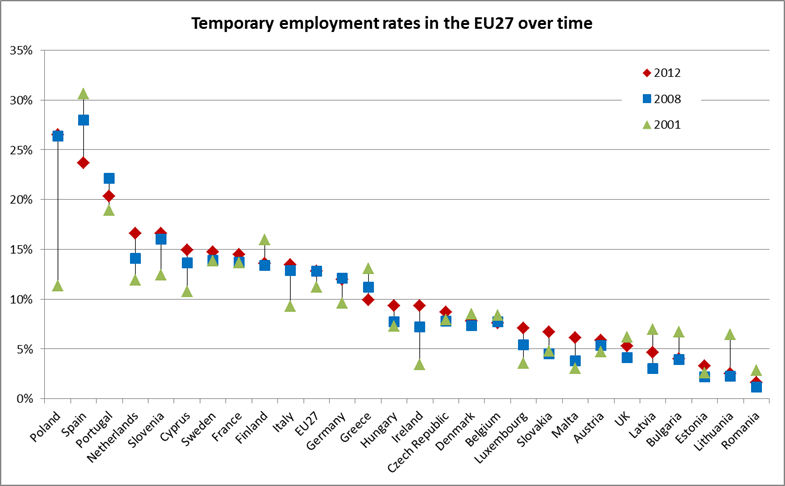The rise of temporary contracts in Europe
More than one in 10 employees in the EU are employed on temporary contracts, but a majority of them would prefer a permanent contract. Temporary contracts help employers to manage their labour demand, but there are downsides for employees, such as job insecurity and lower pay.
Temporary employment has been rising across many European countries for at least three decades. This is largely the result of reforms loosening employment protection legislation, which gives employers greater flexibility to adjust their workforces when their circumstances change and reduces the cost. Workers on a temporary contract can be let go simply by non-renewal of their contracts, and the costs may be effectively zero; it can be much more difficult and costly to terminate permanent contracts.
The number of temporary employees grew by 25% in the EU27 between 2001 and 2012, compared with a growth rate of 7% in permanent employees. While this higher growth of temporary contracts occurred in two-thirds of EU countries, the absolute gains are largely attributable to five countries: Poland (2 million), Germany (1.1 million), Italy (900,000), France (400,000) and the Netherlands (300,000). However, Spain lost almost half a million temporary jobs in net terms in the same period, while the UK lost almost 140,000.
Impact of the crash
Temporary employment levels fell dramatically after the economic crash in 2008 as businesses that moved to reduce their workforces chose the non-renewal of temporary contracts as a first line of action. In Spain, temporary employees suffered the heaviest burden of the labour market adjustment, and their net numbers were reduced by 1.2 million between 2008 and 2012.
But the numbers bounced back quickly after the peak of the crisis. Uncertain of economic prospects, employers that needed to recruit opted for temporary employment to a much greater extent than previously: between 2010 and 2012, half of new recruits were hired on temporary contracts, compared with 40% in 2002. The proportion was around 80% in Spain and Poland.
In 2012, 13% of all employees across the EU27 were working under a temporary contract, compared with 11% in 2001. There is much variation in rates across EU countries as the figure below illustrates. Over a quarter of workers were on temporary contracts in Poland in 2012 and over one-fifth in Spain and Portugal, while rates were lower than 5% in Latvia, Bulgaria, Estonia, Lithuania and Romania.

Source: European Union Labour Force Survey
Involuntary temporary status
Is there a problem with temporary employment? A recent report from Eurofound indicates there may be.
Firstly, most workers in the EU are temporary involuntarily – 64% say they are temporary because they could not find a permanent job – but transitioning out of temporary employment is not always easy. Between 2011 and 2012, just one in five temporary employees in the EU as a whole made that transition. A similar proportion moved into non-employment, while the equivalent figure for permanent employees was much lower (7%).
Lower pay
Secondly, temporary employees are paid less than their permanent counterparts, on average 19% less across European countries, according to Eurofound’s analysis of data from the 2010 Structure of Earnings Survey (SES). This negative wage gap exists across all 19 EU countries covered by the SES, apart from Estonia. It tends to be wider in those countries with a higher rate of temporary employment. The gap exists even when temporary employees are compared to permanent short-tenured employees across most countries, indicating that the lower wages for temporary employees are not only due to their shorter job tenures.
There is also a negative wage gap, of 14%, related to temporary status within the average company in all countries except Lithuania. This means temporary employees usually receive lower wages than their permanent counterparts due to pay differentials existing within companies and as well between companies since temporary employees are more likely to work in those companies characterised by relatively lower pay levels.
Labour market segmentation
Several findings in the Eurofound report point towards the existence of labour market segmentation in some Member States; that is, the labour force tends to split into two segments, with limited mobility between them. One of the segments, where temporary employees are more likely to be found, is characterised by more job insecurity, poorer labour market prospects and lower pay levels, while the other segment, typically comprised of employees under permanent contracts, enjoys higher levels of job security, better pay and opportunities for career progression.
Author
Eurofound
The European Foundation for the Improvement of Living and Working Conditions (Eurofound) is a tripartite European Union Agency, whose role is to provide knowledge to assist in the development of better social, employment and work-related policies. Eurofound was established in 1975 by Council Regulation (EEC) No. 1365/75 to contribute to the planning and design of better living and working conditions in Europe. Find out more: Who we are.
Related content
15 December 2015
Temporary employment has increased since the 1980s in most European countries as a result of demands for greater flexibility in labour markets and subsequent reforms of employment protection legislation. This report presents a broad picture of temporary employment across the EU27 between 2001 and 2012 based on Eurostat data. It maps the recent evolution of temporary employment, before and after the economic crisis. It calculates the wage gap between temporary and permanent employees and also analyses the wage gap within companies. The report also identifies the main determinants of temporary employment in terms of personal, company and job characteristics and examines the most relevant labour market transitions for temporary employees. The study finds evidence of segmentation in a number of European labour markets, whereby temporary employees have poor pay and labour market prospects, while permanent employees enjoy high levels of job security and opportunities for career progression.




&w=3840&q=75)
&w=3840&q=75)
&w=3840&q=75)